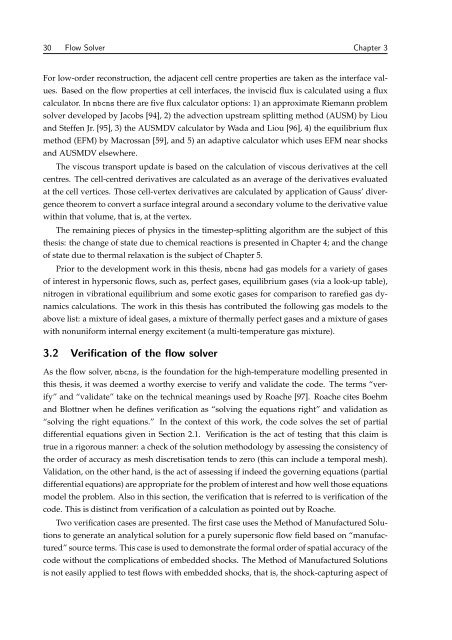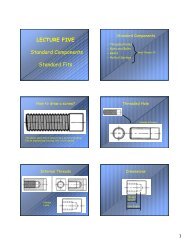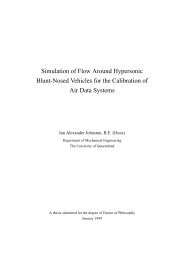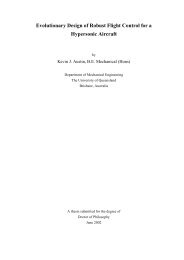Rowan-Gollan-PhD-Thesis - Mechanical Engineering - University of ...
Rowan-Gollan-PhD-Thesis - Mechanical Engineering - University of ...
Rowan-Gollan-PhD-Thesis - Mechanical Engineering - University of ...
You also want an ePaper? Increase the reach of your titles
YUMPU automatically turns print PDFs into web optimized ePapers that Google loves.
30 Flow Solver Chapter 3<br />
For low-order reconstruction, the adjacent cell centre properties are taken as the interface val-<br />
ues. Based on the flow properties at cell interfaces, the inviscid flux is calculated using a flux<br />
calculator. Inmbcns there are five flux calculator options: 1) an approximate Riemann problem<br />
solver developed by Jacobs [94], 2) the advection upstream splitting method (AUSM) by Liou<br />
and Steffen Jr. [95], 3) the AUSMDV calculator by Wada and Liou [96], 4) the equilibrium flux<br />
method (EFM) by Macrossan [59], and 5) an adaptive calculator which uses EFM near shocks<br />
and AUSMDV elsewhere.<br />
The viscous transport update is based on the calculation <strong>of</strong> viscous derivatives at the cell<br />
centres. The cell-centred derivatives are calculated as an average <strong>of</strong> the derivatives evaluated<br />
at the cell vertices. Those cell-vertex derivatives are calculated by application <strong>of</strong> Gauss’ diver-<br />
gence theorem to convert a surface integral around a secondary volume to the derivative value<br />
within that volume, that is, at the vertex.<br />
The remaining pieces <strong>of</strong> physics in the timestep-splitting algorithm are the subject <strong>of</strong> this<br />
thesis: the change <strong>of</strong> state due to chemical reactions is presented in Chapter 4; and the change<br />
<strong>of</strong> state due to thermal relaxation is the subject <strong>of</strong> Chapter 5.<br />
Prior to the development work in this thesis, mbcns had gas models for a variety <strong>of</strong> gases<br />
<strong>of</strong> interest in hypersonic flows, such as, perfect gases, equilibrium gases (via a look-up table),<br />
nitrogen in vibrational equilibrium and some exotic gases for comparison to rarefied gas dy-<br />
namics calculations. The work in this thesis has contributed the following gas models to the<br />
above list: a mixture <strong>of</strong> ideal gases, a mixture <strong>of</strong> thermally perfect gases and a mixture <strong>of</strong> gases<br />
with nonuniform internal energy excitement (a multi-temperature gas mixture).<br />
3.2 Verification <strong>of</strong> the flow solver<br />
As the flow solver, mbcns, is the foundation for the high-temperature modelling presented in<br />
this thesis, it was deemed a worthy exercise to verify and validate the code. The terms “ver-<br />
ify” and “validate” take on the technical meanings used by Roache [97]. Roache cites Boehm<br />
and Blottner when he defines verification as “solving the equations right” and validation as<br />
“solving the right equations.” In the context <strong>of</strong> this work, the code solves the set <strong>of</strong> partial<br />
differential equations given in Section 2.1. Verification is the act <strong>of</strong> testing that this claim is<br />
true in a rigorous manner: a check <strong>of</strong> the solution methodology by assessing the consistency <strong>of</strong><br />
the order <strong>of</strong> accuracy as mesh discretisation tends to zero (this can include a temporal mesh).<br />
Validation, on the other hand, is the act <strong>of</strong> assessing if indeed the governing equations (partial<br />
differential equations) are appropriate for the problem <strong>of</strong> interest and how well those equations<br />
model the problem. Also in this section, the verification that is referred to is verification <strong>of</strong> the<br />
code. This is distinct from verification <strong>of</strong> a calculation as pointed out by Roache.<br />
Two verification cases are presented. The first case uses the Method <strong>of</strong> Manufactured Solu-<br />
tions to generate an analytical solution for a purely supersonic flow field based on “manufac-<br />
tured” source terms. This case is used to demonstrate the formal order <strong>of</strong> spatial accuracy <strong>of</strong> the<br />
code without the complications <strong>of</strong> embedded shocks. The Method <strong>of</strong> Manufactured Solutions<br />
is not easily applied to test flows with embedded shocks, that is, the shock-capturing aspect <strong>of</strong>







